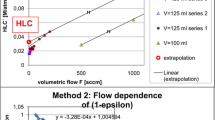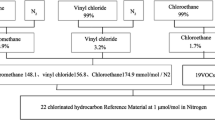Abstract
To develop accurate quantitation methods for two major permanent gases, N2 and O2, a series of calibration experiments were carried out using a gas chromatograph (GC)/barrier discharge ionization detector (BID) equipped with a large-volume injection (LVI) system. To this end, gaseous working standards (WSs) diluted with helium gas were prepared at ten different concentration levels representing three different concentration ranges (in ppm) in 1-L polyester aluminum (PEA) bags ((1) low, 209~2090 (O2) and 791~7910 (N2); (2) moderate, 2090 ~ 20,900 (O2) and 7910~79,100 (N2); and (3) high, 20,900~209,000 (O2) and 79,100~791,000 (N2)). Cross-calibration experiments for each individual WS were carried out using the loop injection system with four different capacities (0.01, 0.5, 1, and 10 mL). The calibration results were then evaluated with respect to key variables including loop capacity, concentration, and mass quantity. Accordingly, we observed the optimal performance of the BID in terms of sensitivity and linearity (R 2 > 0.98) when the WS of the moderate concentration range was analyzed with the small loop (0.01 and 0.5 mL). The method detection limit (MDL) values of the four loop sizes (between 0.01 and 10 mL) were 7~500 ng for O2 (38.4~557 ppm) and 24~2230 ng for N2 (195~2105 ppm).


Similar content being viewed by others
References
Cai, H., & Stearns, S. D. (2013). Pulsed discharge helium ionization detector with multiple combined bias/collecting electrodes for gas chromatography. Journal of Chromatography A, 1284, 163–173.
Frink, L. A., Weatherly, C. A., & Armstrong, D. W. (2014). Water determination in active pharmaceutical ingredients using ionic liquid headspace gas chromatography and two different detection protocols. Journal of Pharmaceutical and Biomedical Analysis, 94, 111–117.
Gras, R., Luong, J., Monagle, M., & Winniford, B. (2006). Gas chromatographic applications with the dielectric barrier discharge detector. Journal of Chromatographic Science, 44, 101–107.
Gras, R., Luong, J., Hawryluk, M., & Monagle, M. (2010). Analysis of part-per-billion level of arsine and phosphine in light hydrocarbons by capillary flow technology and dielectric barrier discharge detector. Journal of Chromatography a, 1217, 348–352.
Iguchi, S., Teramura, K., Hosokawa, S., & Tanaka, T. (2015). Effect of the chloride ion as a hole scavenger on the photocatalytic conversion of CO2 in an aqueous solution over Ni-al layered double hydroxides. Physical Chemistry Chemical Physics, 17, 17995–18003.
Jin, Q., Yang, W., Yu, A., Tian, X., & Wang, F. (1997). Helium direct current discharge ionization detector for gas chromatography. Journal of Chromatography A, 761, 169–179.
Kim, K.-H. (2006). The properties of calibration errors in the analysis of reduced sulfur compounds by the combination of a loop injection system and gas chromatography with pulsed flame photometric detection. Analytica Chimica Acta, 566, 75–80.
Kim, K.-H., & Nguyen, H. T. (2007). Effects of injection volume change on gas chromatographic sensitivity determined with two contrasting calibration approaches for volatile organic compounds. Journal of Separation Science, 30, 367–374.
Kim, Y.-H., Ahn, J.-W., & Kim, K.-H. (2010). Detection properti es of malodorous amine compounds by the gas chromatography/nitrogen phosphorous detector (GC/NPD) method. Korean Journal of Odor Research and Engineering, 9(3), 133–141.
Luong, J., Gras, R., Cortes, H. J., & Shellie, R. A. (2013). Multidimensional gas chromatography for the characterization of permanent gases and light hydrocarbons in catalytic cracking process. Journal of Chromatography a, 1271, 185–191.
Pascale, R., Caivano, M., Buchicchio, A., Mancini, I. M., Bianco, G., & Caniani, D. (2017). Validation of an analytical method for simultaneous high-precision measurements of greenhouse gas emissions from wastewater treatment plants using a gas chromatography-barrier discharge detector system. Journal of Chromatography a, 1480, 62–69.
Rensburg, M. J. V., Botha, A., & Rohwer, E. (2007). Analysis of trace amounts of carbon dioxide, oxygen and carbon monoxide in nitrogen using dual capillary columns and a pulsed discharge helium ionisation detector. Journal of Chromatography A, 1167, 102–108.
Roberge, M. T., Finley, J. W., Lukaski, H. C., & Borgerding, A. J. (2004). Evaluation of the pulsed discharge helium ionization detector for the analysis of hydrogen and methane in breath. Journal of Chromatography A, 1027, 19–23.
Shinada, K., Horiike, S., Uchiyama, S., Takechi, R., & Nishimoto, T. (2012). Development of new ionization detector for gas chromatography by applying dielectric barrier discharge. Shimadzu Hyoron, 69, 255–263.
Teske, J., & Engewald, W. (2002). Methods for, and applications of, large-volume injection in capillary gas chromatography. Trends in Analytical Chemistry, 21, 584–593.
Ullah, M. A., Kim, K.-H., & Szulejko, J. E. (2015). The effect of solvent selection in the gas chromatographic analysis of aldehydes in air samples after derivatization with pentafluorophenyl hydrazine. Atmospheric Research, 166, 101–109.
Wang, Z., Lock, N., Whitney, R. & Taylor, C. M. (2014). New applications using GC BID detector. Shimadzu Corporation, http://www.shimadzu.com/an/literature/gc/sic114141.html.
Weatherly, C. A., Woods, R. M., & Armstrong, D. W. (2014). Rapid analysis of ethanol and water in commercial products using ionic liquid capillary gas chromatography with thermal conductivity detection and/or barrier discharge ionization detection. Journal of Agricultural and Food Chemistry, 62, 1832–1838.
Acknowledgements
The corresponding author (KHK) acknowledges support made in part by grants from the National Research Foundation of Korea (NRF) funded by the Ministry of Science, ICT & Future Planning (No. 2016R1E1A1A01940995).
Author information
Authors and Affiliations
Corresponding author
Electronic supplementary material
ESM 1
(DOCX 465 kb).
Rights and permissions
About this article
Cite this article
Jo, SH., Kim, KH. The applicability of a large-volume injection (LVI) system for quantitative analysis of permanent gases O2 and N2 using a gas chromatograph/barrier discharge ionization detector. Environ Monit Assess 189, 317 (2017). https://doi.org/10.1007/s10661-017-6024-1
Received:
Accepted:
Published:
DOI: https://doi.org/10.1007/s10661-017-6024-1




